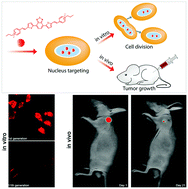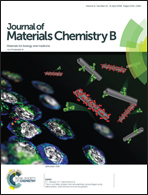Real-time imaging of cancer cell generations and monitoring tumor growth using a nucleus-targeted red fluorescent probe†
Abstract
Real-time and long-term nucleus labeling is of great significance for understanding and elucidating cellular and molecular processes in the life sciences, such as gene expression, replication, recombination, and repair, but remains challenging because of the lack of ideal imaging probes. Traditional commercial DNA stains for live-cell imaging either suffer from low water solubility, high cytotoxicity and photobleaching or have small Stokes shifts and low ultraviolet (UV) light excitation; these intrinsic drawbacks limit their utility. Here, a far-red DNA stain (PTB) is explored for in vitro long-term nucleus tracking and in vivo tumor growth monitoring. PTB exhibits a large Stokes shift (∼110 nm), far-red emission (625 nm), and a 73.8-fold increase in fluorescence upon binding with DNA. Compared to currently used nucleus stains, PTB also displays low cytotoxicity and good photostability and biocompatibility. More importantly, the results of in vitro studies reveal that PTB can be tracked in stained HepG-2 cancer cells for up to 11 generations. Moreover, PTB demonstrates effective long-term (i.e., 21 days) tumor growth imaging in vivo. The combination of these remarkable properties makes PTB a promising far-red DNA stain.



 Please wait while we load your content...
Please wait while we load your content...